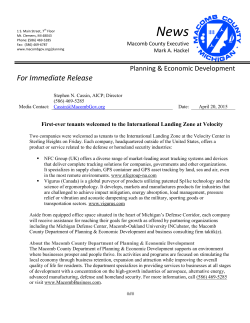
May 14, 2015 â Letter-to-President Obama
May 14, 2015 President Barack Obama President of the United States The White House 1600 Pennsylvania Ave. NW Washington, D.C. 20500 Dear Mr. President, We need your personal intervention to provide for the protection of the American people against an existential threat posed by natural and manmade electromagnetic pulse (EMP). The consequent failure of critical infrastructures that sustain our lives is a major national security threat and would be catastrophic to our people and our nation. The National Intelligence Council, which speaks for the entire U.S. Intelligence Community, published in its 2012 unclassified Global Trends 2030 report that an EMP is one of only eight Black Swan events that could change the course of global civilization by or before 2030. No official study denies the view that an EMP is a potentially catastrophic societal threat that needs to be addressed urgently. America is not prepared to be without water, electricity, telephones, computer networks, heating, air conditioning, transportation (cars, subways, buses, airplanes), and banking. All the benefits of our just-in-time economy would come to a deadly halt, including the production of petroleum products, clothing, groceries and medicine. Think about cities without electricity to pump water to their residents. Some signatures to this letter are from people who—like a growing number of Americans—have only recently learned about the EMP threat and find it hard to believe that our government has permitted it to continue. They joined in signing because they, in representing those same Americans, wish to show broad support for qualified experts ending this vulnerability as quickly as possible. An EMP is like a super-energetic radio wave from natural or manmade causes that can damage and destroy electronic systems across vast regions, potentially across the entire continental United States, across Europe, or any other country that has not hardened its electric power grid. Russia and China have substantially hardened their electric grids. Other nations are beginning to harden theirs. But the United States has done little or nothing to counter this threat. We urge you immediately to issue a Presidential Study Directive (PSD) directing your National Security Advisor to lead a focused interagency effort to provide, in connection with your current budget execution activities and future budget requests, a specific program to address this natural and manmade threat. In particular, this PSD should direct that hardening technology, well known in the Department of Defense, be exploited by all agencies with responsibility for maintaining the electric power grid. It is imperative that plans are immediately implemented to protect America’s at least 100 nuclear reactors and their co-located spent fuel storage facilities from an EMP. It should also take into account bipartisan congressional initiatives, such as the Secure High-Voltage Infrastructure for Electricity from Lethal Damage (SHIELD) Act and the Critical Infrastructure Protection Act (CIPA). A coronal mass ejection from the Sun can generate a natural EMP with catastrophic consequences. A geomagnetic super-storm in 1859 called the Carrington Event caused worldwide damage and fires in telegraph stations and other primitive electronics, which at the time were not necessary for societal survival. In contrast, today a Carrington-class geomagnetic super-storm—expected every 1 century or so—could collapse electric grids and destroy critical infrastructure everywhere on Earth. We know it will happen; we just don’t know when, but we know humanity can’t risk being unprepared. In July 2012, we missed a repeat by only a few days when a major solar emission passed through the Earth’s orbit just after planet Earth passed. NASA recently warned that the likelihood of such a geomagnetic super-storm is 12-percent per decade; so it is virtually certain that a natural EMP catastrophe shall occur within our lifetime or that of our children. As we have known for over a half-century from actual test data, even more damaging EMP effects would be produced by any nuclear weapon exploded a hundred miles or so above the United States, possibly disabling everything that depends on electronics for control or operations within a line of sight from the explosion. Electricity networks could be shut down indefinitely until major repairs could be made, and this could take months, even years. Cascading failures from even a lower altitude nuclear burst over the northeastern U.S. could indefinitely shut down the electric grid that produces three quarters of U.S. electric power. Computers would be incapacitated. Supply chains would shut down. Imagine Hurricane Sandy affecting a much larger area without the immediate physical damage but also without any hope for relief supplies. Russia and China have already developed nuclear EMP weapons and many believe others possess EMP weapons including North Korea and soon Iran—and likely their terrorist surrogates. For example, they could launch nuclear-armed short or medium range missiles from near our coasts, possibly hiding the actual sponsor from retaliation. North Korea and Iran have tested their missiles in ways that can execute effective EMP attacks from ships or from satellites that approach the U.S. from the south where our ballistic missile warning systems are minimal. The technology to mitigate these effects is well known and used by the Department of Defense for decades to harden our strategic nuclear systems to assure that the U.S. has the ability to retaliate should we be attacked. But such technology and commitment to ongoing maintenance have not been used to harden our critical national infrastructure. In addition, our ballistic missile defense (BMD) systems have not yet been focused on this problem. For example, you could reinforce your recent Enhanced Defense Cooperation Agreement with the Philippines by jointly installing an Aegis Ashore BMD site in the Philippines—like those being placed in Romania and Poland—to support the defense of the Philippines and to provide advanced warning and information to support our homeland defense. We urge that the above mentioned PSD assure funding to harden the critical elements of our electric power grid and especially our nuclear facilities to assure their recovery from either a natural or manmade EMP event. These efforts can be guided by a mainstream scientific consensus, first established by the congressionally mandated EMP Commission, which examined nuclear and natural EMP and delivered its first classified report to Congress in 2004 and its final unclassified report in 2008. The National Academy of Sciences subsequently independently re-examined the EMP Commission's warnings about the consequences of a geomagnetic super-storm and arrived at the same conclusion and endorsed the recommendations of the EMP Commission. Several other nonpartisan reviews have also concurred. The EMP Commission recommended a cost-effective plan, endorsed by all subsequent U.S. government studies, to protect, within a few years, U.S. critical infrastructures from the worst effects of EMP. The Commission estimated a one-time cost of $2 billion for EMP protection of the national electric grid, which is about what the U.S. gives to Pakistan every year in foreign aid. 2 In addition, we urge that your PSD include near-term improvements to our operating ballistic missile defense (BMD) systems to assure they can defend against the manmade EMP threats as quickly as possible—before the electric grid can be hardened. Our already operating Aegis BMD systems (over 30 ships at sea and Aegis Ashore Sites in Hawaii and being deployed in Romania and Poland) and Ground-Based Interceptors (on Vandenberg Air Force Base, California) can be used to counter the threats from the South and from vessels off our coasts, with minor modifications and if their crews are trained to do so. No additional development costs are necessary and deployment costs would be less than approved for our overseas deployments to defend our European allies against Iranian ballistic missiles. Mr. President, both Republicans and Democrats have known how to deal with this issue for at least thirty years but have done nothing about it. Bipartisan efforts in Congress have failed in spite of the fact that neither technology nor expense should be an issue. Dealing effectively with this issue is a matter of achieving the needed political leadership and will. The American people need you to lead the efforts to protect our nation from an EMP catastrophe. We write to urge you to pursue our request. Sincerely yours, Dr. George Baker - Former U.S. Defense Nuclear Agency EMP Program Director, Professor Emeritus on Critical Infrastructure Protection, James Madison University. Rep. Roscoe Bartlett (R-MD) (Rtd.) - Father of the Congressional EMP Commission Jen Bawden - Task Force on National and Homeland Security and Member of the Steering Committee of the Secure the Grid Coalition Senator Rudy Boschwitz (R-MN) (Rtd.) - Former U.S. Ambassador to the UN Human Rights Commission, President G.H.W. Bush's Emissary to Ethiopia (1991) Ambassador Henry F. Cooper - Former Director of the Strategic Defense Initiative, Chief U.S. Negotiator in the Geneva Defense and Space Talks, Deputy Assistant Secretary of the Air Force for Strategic and Space Systems Thomas Donnelly - Co-Director of the Marilyn Ware Center for Security Studies at AEI. Fritz Ermarth - Former Chairman National Intelligence Council, Director of National Security Programs, Nixon Center. Frank J. Gaffney, Jr. - Former Assistant Secretary of Defense for International Security Policy Jerry Goodwin - President of the Association of Former Intelligence Officers (AFIO) New York Metropolitan Chapter Dr. William R. Graham - Former Chair of the EMP Commission, Science Advisor to President Reagan, Director of White House Science and Technology Policy, and NASA Administrator Professor Sam Hayes (Rtd.) - Jacob H. Schiff Professor of Investment Banking, Emeritus , Harvard Business School David Hunt - Former CIA Senior Clandestine Service Officer and Former FBI Chief of Station, NYC John Kappenman - Space Weather Consultant to Departments of Defense, Homeland Security, and EMP Commission; Designer ACE Satellite and EMP Blocking Devices; President, Storm Analysis Consultants. Senator Jon Kyl (R-AZ) (Rtd.) - Co-chair of AEI's American Internationalism Project Robert Laidley - President, The Atlantic and Conservation Institute Senator Joseph Lieberman (I-CT) (Rtd.) - Co-chair of AEI's American Internationalism Project Herb London - President of the London Center for Policy Research, New York 3 Vice Admiral Robert Monroe (Rtd.) - Former Director U.S. Defense Nuclear Agency. Major General Robert Newman (Rtd.) - Former Adjutant General of Virginia Michael O’Hanlon - Senior Fellow, Brookings Institution, specializing in defense and foreign policy issues. Dr. Robert L. Pfaltzgraff - President of the Institute for Foreign Policy Analysis Inc. and Shelby Cullom Devis Professor of International Security Studies, The Fletcher School, Tufts University Danielle Pletka - Senior Vice President for foreign and defense policy studies at AEI. Dr. Peter Vincent Pry - Former Congressional EMP Commission, Congressional Strategic Posture Commission, House Armed Services Committee, CIA, Executive Director Task Force on National and Homeland Security. Dr. Gary J. Schmitt - Co-Director of the Marilyn Ware Center for Security Studies at AEI Dr. George Schwab - President of the National Committee on American Foreign Policy Admiral James Stavridis (Rtd.) - Dean of the Fletcher School. Former NATO Supreme Allied Commander (2009-2013) Ambassador Kurt Volker - Former United States Ambassador to NATO The Hon. David M. Walker - Former U.S. Comptroller General Rep. Curtis Weldon (R-PA) (Rtd.) - Former Vice Chairman of the House Armed Services Committee and the House Homeland Security Committee; and Co-chair of the Duma-Congress Study Group, the official inter-parliamentary relationship between the United States and Russia; Sponsor of the 1998 EMP Commission Legislation John Whitehead - Former Senior Partner and Co-Chairman Goldman Sachs, Chairman Emeritus Brookings Institution, Former Deputy Secretary of State, Former Chairman AEA Investors, Former Chairman The International Rescue Committee, Former Chairman The Asia Society, Director of The Nature Conservancy, and Former Chairman of the Federal Reserve Bank of New York. Died February 7th, 2015 Ambassador James Woolsey - Former Director of Central Intelligence Copies to Administration Officials: The Hon. Joseph Biden, Vice President of the United States The Hon. John Kerry, Secretary of State The Hon. Ashton Carter, Secretary of Defense The Hon. Ernest Moniz, Secretary of Energy The Hon. Jeh Johnson, Secretary of Homeland Security Copies to Media Executives: Mark Thompson - CEO, The New York Times Robert Thomson - CEO, The Wall Street Journal Mike Perlis - CEO, Forbes Allison W. Phinney, Jr. - The Christian Science Monitor John Ridding – CEO, The Financial Times Andrew Rashbass - CEO, Thomson Reuters Michael Bloomberg – CEO. Bloomberg L.P. (2015) John Micklethwait - Editor-in-Chief, Bloomberg News Zanny Minton Beddoes - Editor-in-Chief, The Economist Harold McGraw CEO - McGraw Hill Financial Marty Baron - Executive Editor, The Washington Post Jeffrey Bezos - The Washington Post 4
© Copyright 2025










